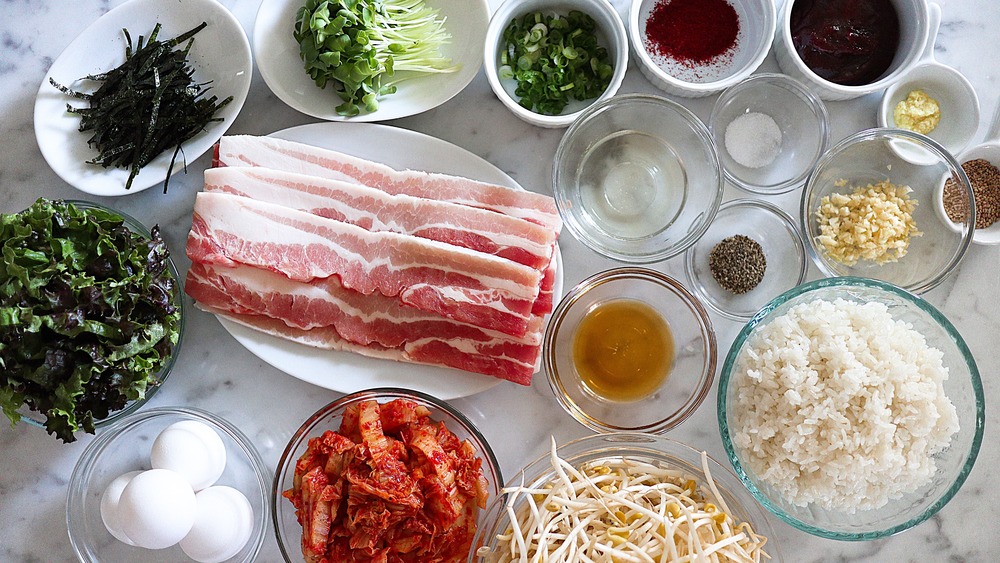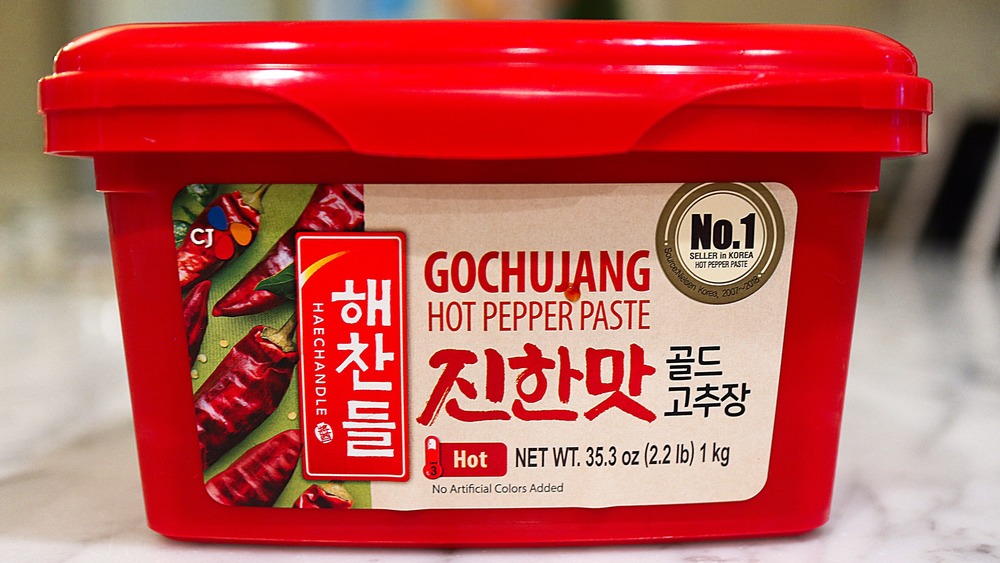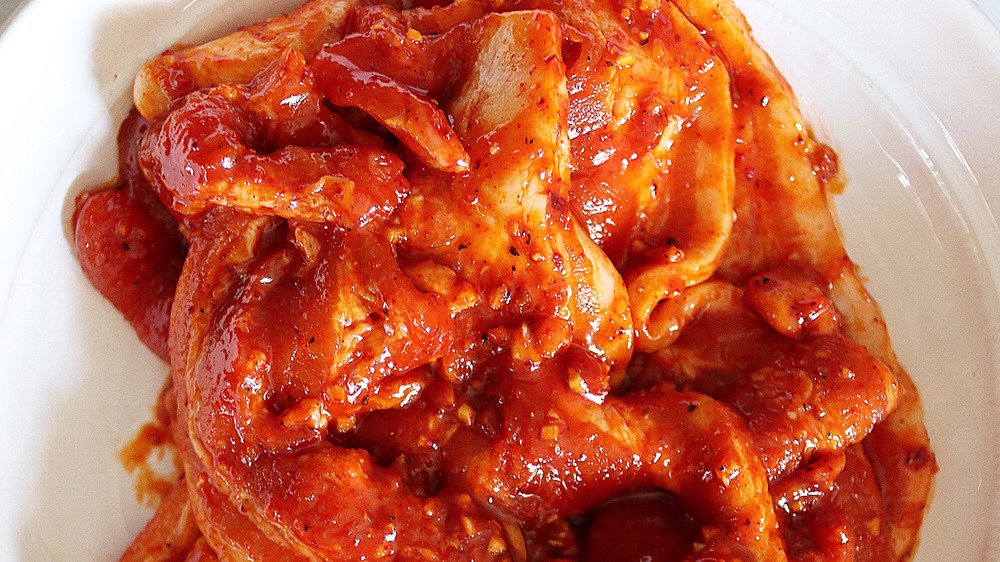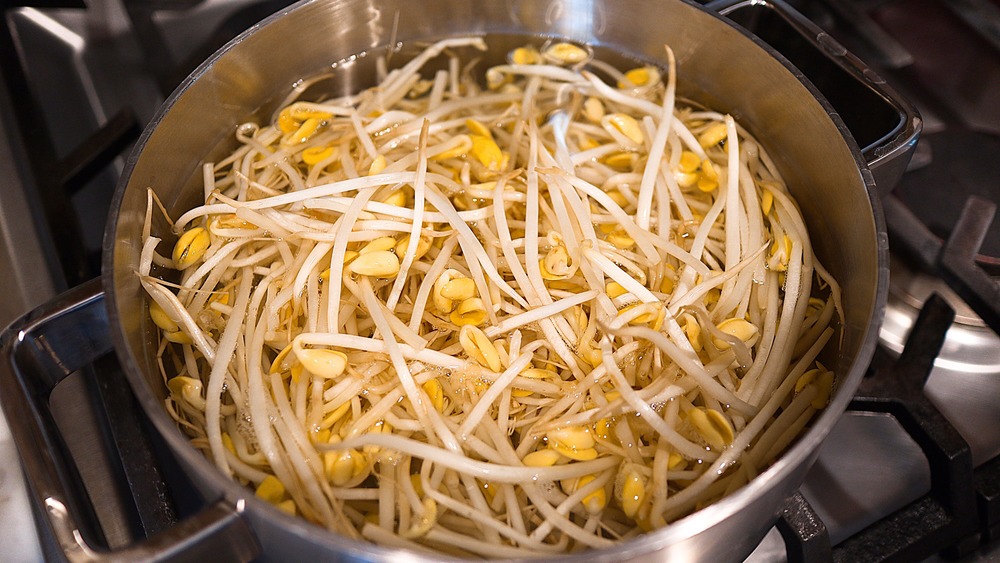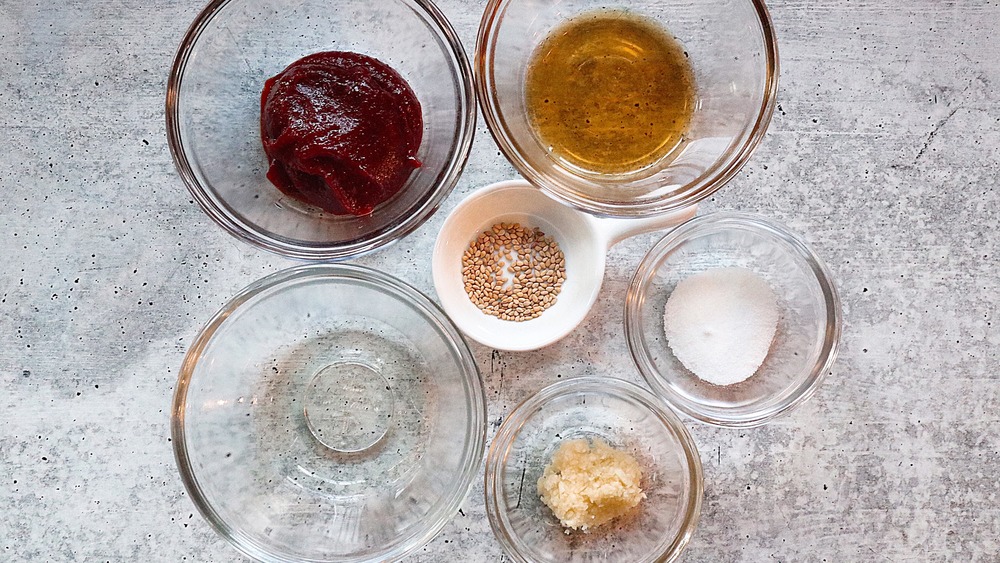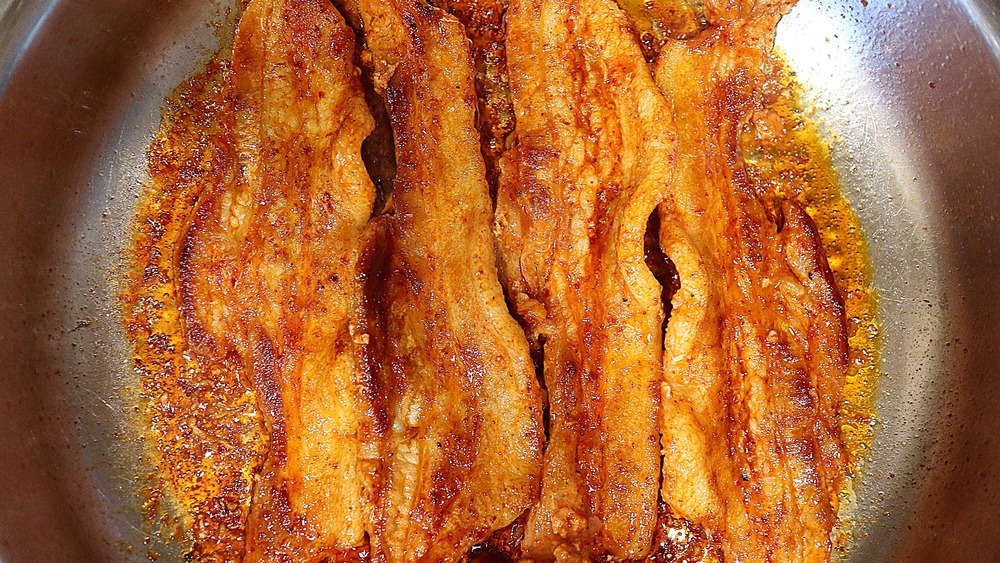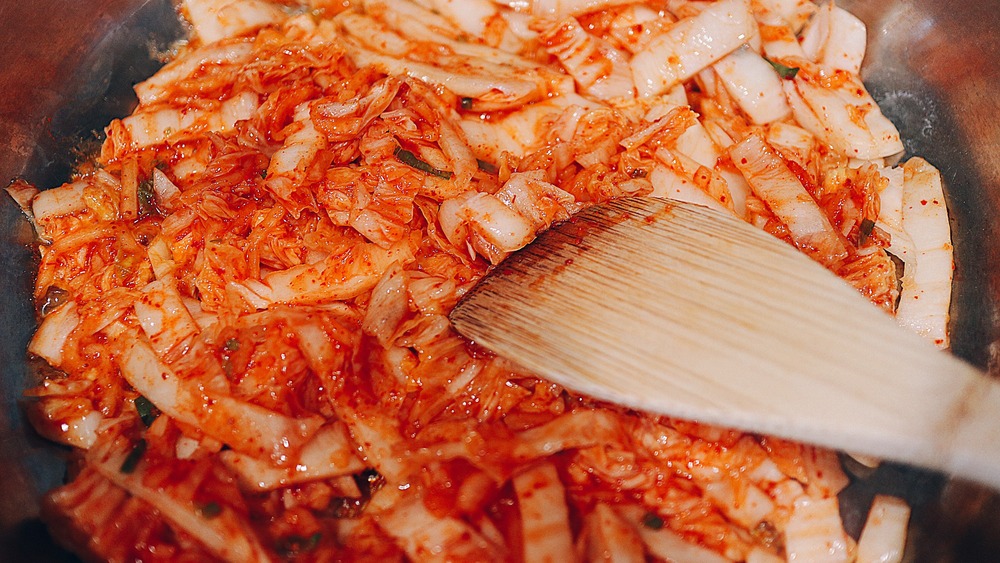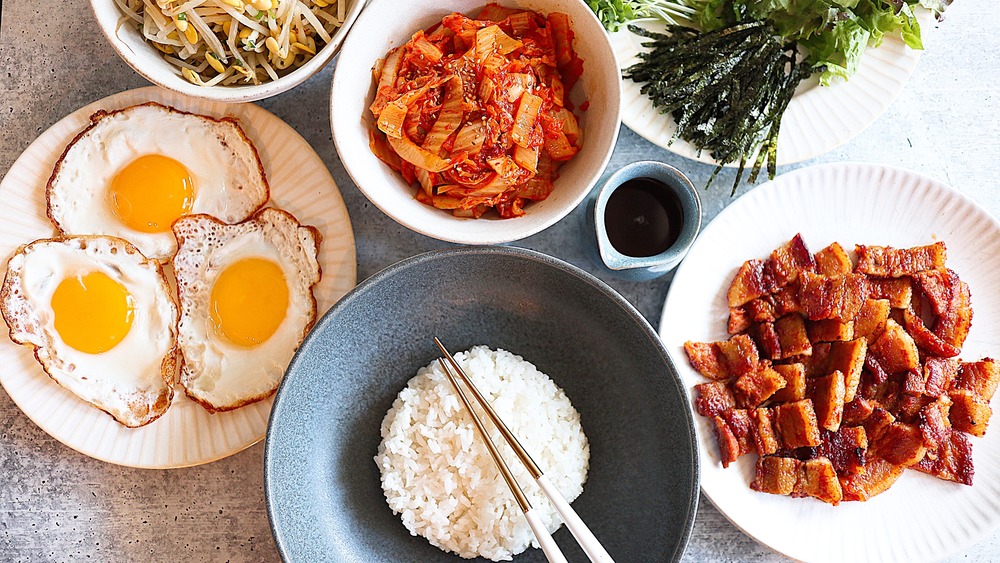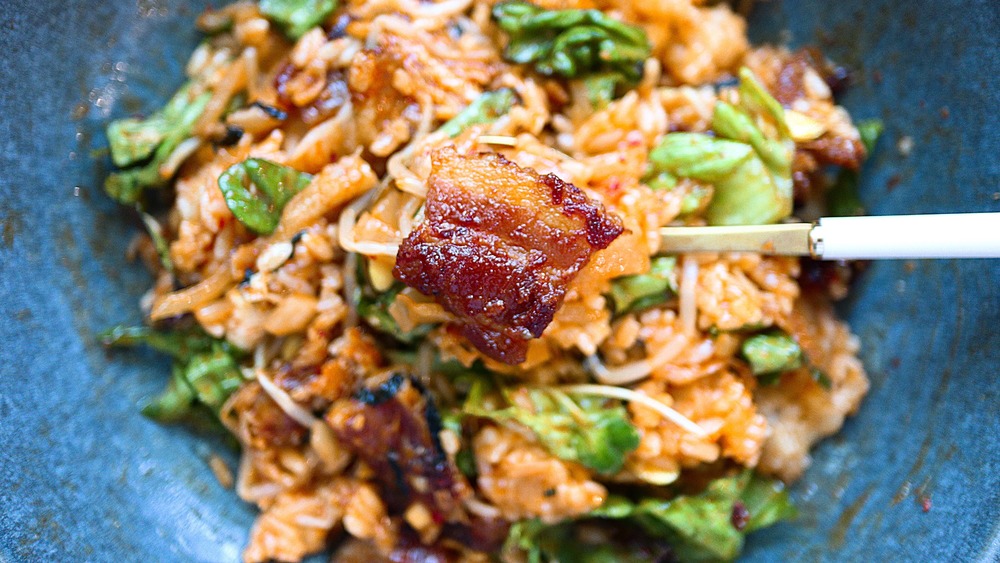Easy Bibimbap Recipe
Bibimbap, bibimbap, bibimbap ... could there be a more fun food word to say? Some, perhaps, may have first encountered bibimbap on the menu at a Korean restaurant and ordered it, not even knowing what it was, just for the sheer joy of feeling the word bounce out of their mouths. Once it arrived on their plates, they would no doubt have been pleasantly surprised, since bibimbap is just as much fun to eat as it is to say.
While this classic Korean dish may seem like the kind of thing you can only get in a restaurant, something well beyond the scope of the ordinary home kitchen to produce, that is actually not the truth. Food photographer and recipe developer Cecilia Ryu, herself a first-generation Korean-American, reassures us that "This dish isn't difficult but just has a lot of steps." She explains how the dish got its name, telling us "The word 'bibimbap' literally means 'mixed rice.' "Bibim" means mixed and "bap" means rice." She says she chose this dish because "bibimbap is such an iconic Korean dish. I feel bibimbap is a gateway for those who are trying Korean cuisine for the first time."
Gather your ingredients for your bibimbap
Unless you have an incredibly well-stocked kitchen, you are probably going to have to do a grocery run before you make your bibimbap. You know all those quick-and-easy recipes with just a handful of ingredients? This isn't one of them. It has 23 ingredients in all, and a few of these are things you're not too likely to have on hand unless you cook Korean food on a regular basis.
Some of the ingredients, of course, are basic household staples: soy sauce, brown sugar, black pepper, sugar, canola oil, salt, white rice, and eggs. You'll also need some fresh produce. While ginger, garlic, scallions, and red leaf lettuce can be readily found in most supermarkets, soy bean sprouts and radish sprouts or microgreens might require a little more effort to track down.
You may have to hit up a few specialty stores to make this bibimbap
Some of the ingredients for this bibimbap may require you to make a special trip, depending on how extensive the selection at your local supermarket may be. While pork belly has become popular in recent years thanks to hipster foodie culture (and possibly low-carb diets), you still might need to find an actual butcher shop or at least a specialty grocer to buy it from. If you can't find pork belly, though, the more readily available pork shoulder makes an acceptable substitute.
Several important ingredients, however, will require a visit to an Asian grocer, or you can order online if that's not an option. You'll need both gochugaru (Korean red pepper flakes) and gochujang (Korean red pepper paste). Ryu cautions that "the spice level of gochujang varies depending on the brand," and says that usually when you're purchasing this condiment, the heat level is indicated right on the container. You should also pick up some mirin (a type of rice wine), sesame oil, rice wine vinegar, roasted seaweed, and roasted sesame seeds. Sure, you can always toast your own sesame seeds, but you don't need to. Many Asian groceries sell pre-roasted seeds, as these are a staple in Korean cooking. Oh, and don't forget the kimchi. If you go to a well-stocked Asian market, you may be able to find kimchi made from various types of vegetables, but Ryu insists that "cabbage kimchi would be your only choice in this recipe."
The pork for your bibimbap will need to marinate for a while
The first step in making bibimbap, once you've tracked down all 23 ingredients, is to mix the gochugaru, soy sauce, brown sugar, mirin, minced ginger, and black pepper together in a large bowl along with 1 tablespoon of sesame oil, 1 tablespoon of minced garlic, and a quarter cup of the gochujang.
Slice the pork into strips, then add it to the bowl and mix until each slice is well coated with the marinade. Cover the bowl of pork slices with plastic wrap and place it into the fridge. Let the marinade sit and soak into the pork for at least two hours, although Ryu says it's perfectly okay to marinate it overnight.
Blanch the bean sprouts for your bibimbap since raw ones aren't safe to eat
Raw bean sprouts can be quite the health hazard, as the CDC says that the warm, humid conditions in which they grow can lead to contamination with salmonella, E. coli, or listeria. They do note that the one sure-fire way of rendering sprouts relatively risk-free is to cook them, which is just what you'll be doing here. Unlike mung bean sprouts, Ryu tells us that "soy bean sprouts are always eaten cooked."
All you need to do to cook the sprouts is to boil a large pot of water, then toss them in for just one minute. This blanching technique will allow them to retain some of their crunch while eliminating any potentially nasty bacteria. Drain the sprouts, then scoop them into a bowl and let them cool. You'll be revisiting them again once the meat and kimchi have been cooked.
You can heat the skillet while you whip up the bibimbap sauce
In order to make the bibimbap sauce, you will need to assemble the following ingredients: rice wine vinegar, sugar, sesame oil, the rest of the gochujang, and 1/2 teaspoon of sesame seeds. Got these all properly mise-an-placed? Good. Now you can multi-task by pre-heating a cast-iron skillet or sauté pan over medium heat. While it takes a minute to get heated up, you can measure out and whisk together the first four sauce ingredients in a small bowl, then sprinkle them with the sesame seeds. Set the sauce aside, then turn back to the skillet and check to make sure it's hot enough to cook the pork. Multitasking not your thing? That's okay. Make the sauce first, then heat up the pan.
Keep a careful eye on the pork for your bibimbap as it cooks
Add one tablespoon of canola oil to the pan and then add the sliced pork for your bibimbap. Place the pork in one layer on the pan, as Ryu says this will assure even browning. You'll probably need to cook the pork in several small batches in order to avoid crowding the pieces. Each piece of pork should be fried for about five to ten minutes on each side until nicely browned and cooked all the way through. Keep a close watch on the pan to see that it doesn't get too hot. Ryu says that the oil in the pan shouldn't be smoking, warning: "Avoid heating the pan too high or the marinade will easily burn." Once the pork is cooked, cut each slice into bite-sized pieces (Ryu suggests one-inch squares) and set it aside to cool.
Get the veggies and eggs ready to go for your bibimbap
Chop the kimchi into pieces approximately half an inch in size. Now, heat up a non-stick skillet on medium–high and add the remaining tablespoon of canola oil. Sauté the kimchi for approximately five minutes. Add one teaspoon of sesame oil to the kimchi in the pan, then sauté it for another three minutes. Once the kimchi is done, set it on a plate and sprinkle it with half a teaspoon of sesame seeds. Oh, and if you were thinking of omitting the kimchi since you're not a fan of the stuff — don't! Ryu says, "Most people that do not like kimchi, I always tell them to try cooked kimchi. Cooking creates a different flavor and texture that usually everyone loves."
As the kimchi is cooling, return to the bean sprouts that have been patiently awaiting your return. Stir the sliced scallion into the sprouts (try saying that three times fast!), then add one tablespoon of sesame oil, one teaspoon of salt, one and a half teaspoons of minced garlic, and half a teaspoon of roasted sesame seeds. Tell those sprouts to be patient once again — you'll be back in a sec. One last bit of prep work is needed before the final product is assembled: fry each egg, being careful not to break the yolks or cook them until they're hard. Ryu says you want a runny yolk as this "adds another layer of flavor and richness to the bibimbap [and] it also helps to marry the flavors together."
Time to put the bibimbap all together
And now comes the fun part! (Besides announcing the name of the dish, that is.) Divide the cooked rice among three bowls — large ones, since you'll need a lot of room for all the good things to come. Cover each rice mound with an equal amount of spicy pork, sautéed kimchi, bean sprouts, and red leaf lettuce. Carefully place a fried egg on the top of each heap, then make it look pretty with a garnish of radish sprouts or microgreens and finely-sliced dried seaweed.
Drizzle each bibimbap bowl with one teaspoon of sesame oil, then add one teaspoon or more of bibimbap sauce (depending on how hot you like it) and mix everything up. Ryu does say that "if you prefer to eat the bibimbap less spicy, do not add the sauce when mixing all together." It's okay, the rest of the flavors make the dish equally delicious sans heat.
Bibimbap for solo diners
While the portions given here make three servings, Ryu notes that the marinated meat, the prepared vegetables, and the sauce can all be prepared in advance and should keep in the fridge for a few days. She says this can work not only if you're looking to cut down on prep time on the day you serve the dish but also if you're only looking to make a single serving at a time and have leftovers to enjoy later.
"On the day you want to eat," she tells us, "cook meat and top with prepared kimchi and soy bean sprouts over warm rice and fried egg." She adds that you do not even need to go through the trouble of heating up either the soy bean sprouts or the sautéed kimchi. Instead, just take them out of the fridge about an hour before you plan to make the bibimbap so they can come up to room temperature. The dish will get all the heat it needs from the freshly-cooked rice, meat, and egg.
Bibimbap recipe directions
While this classic Korean dish may seem like the kind of thing you can only get in a restaurant, well beyond the scope of the home kitchen, that's not true.
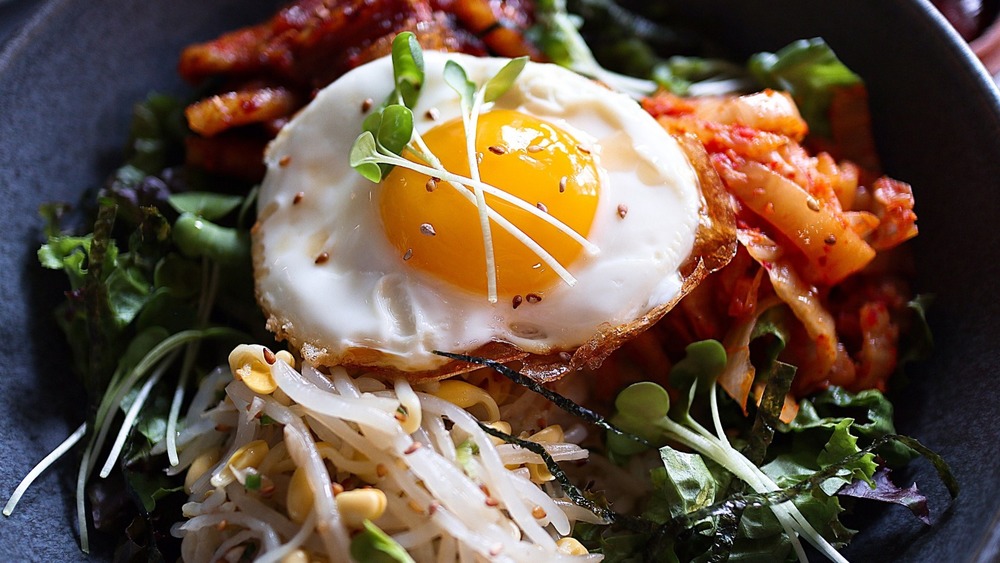
Ingredients
- 1 teaspoon gochugaru (Korean red pepper flakes)
- 1 tablespoon soy sauce
- 3 tablespoons brown sugar
- 2 tablespoons mirin
- ½ teaspoon ginger, minced
- ½ teaspoon black pepper
- 2 tablespoons & 6 teaspoons sesame oil, divided
- 1 tablespoon & 2 ½ teaspoons minced garlic, divided
- ¼ cup & 2 tablespoons gochujang (Korean red pepper paste), divided
- 1 pound sliced pork belly or pork shoulder
- 12-ounce package of soy bean sprouts, washed
- 2 teaspoons rice wine vinegar
- 1 teaspoon sugar
- 1-1/2 teaspoons roasted sesame seeds, divided
- 2 tablespoons canola oil, divided
- 2 cup kimchi, chopped (approx. 1/2-inch pieces)
- 1 scallion, thinly sliced
- 1 teaspoon salt
- 3 eggs
- 3 cups cooked white rice
- 2 cups red leaf lettuce, chopped (approx. ½-inch pieces)
- 1 small bunch of radish sprouts or microgreens
- 3 sheets of roasted seaweed, cut into thin strips
Directions
- In a large bowl, stir together the gochugaru, soy sauce, brown sugar, mirin, minced ginger, black pepper, 1 tablespoon sesame oil, 1 tablespoon minced garlic, and 1/4 cup gochujang.
- Add the sliced pork to the bowl and mix well. Marinate the pork in the refrigerator for at least 2 hours.
- To cook the bean sprouts, bring a large pot of water to a boil. Add the soy bean sprouts and blanch for about 1 minute. Drain and set aside in a bowl to cool.
- To make the bibimbap sauce, combine wine vinegar, sugar, 2 teaspoons sesame oil, 1 teaspoon minced garlic, and 2 tablespoons gochujang in a small bowl. Sprinkle 1/2 teaspoon of sesame seeds on top.
- After the meat has marinated, heat a cast iron skillet or sauté pan on medium heat. Add 1 tablespoon of canola oil. Working in batches, cook the pork for approximately 5 to 10 minutes on each side until nicely browned and cooked through.
- Cut pork into 1-inch bite-size pieces and set aside on a plate.
- To cook the kimchi, heat a non-stick skillet on medium–high heat. Add the remaining 1 tablespoon of canola oil and sauté the kimchi for approximately 5 minutes.
- Add 1 teaspoon of sesame oil to the kimchi and sauté for another 3 minutes.
- Set kimchi aside on a plate and sprinkle 1/2 teaspoon of sesame seeds on top.
- Once sprouts are cooled, add the sliced scallions, salt, 1 tablespoon of sesame oil, 1 teaspoon of salt, 1 ½ teaspoon of minced garlic, and ½ teaspoon of roasted sesame seeds. Mix well and set aside.
- Fry 3 eggs, being careful not to break or cook the yolk.
- To assemble bowl, divide the rice among three large bowls. Arrange an equal amount of spicy pork, sautéed kimchi, bean sprouts, and red leaf lettuce in each bowl. Top each bowl with a fried egg and garnish with the radish sprouts and roasted seaweed.
- Drizzle each bowl with 1 teaspoon of sesame oil. Add 1 teaspoon of the bibimbap sauce or more depending on your taste. Mix all together and enjoy.
Nutrition
| Calories per Serving | 1,398 |
| Total Fat | 104.3 g |
| Saturated Fat | 32.9 g |
| Trans Fat | 0.1 g |
| Cholesterol | 268.8 mg |
| Total Carbohydrates | 81.1 g |
| Dietary Fiber | 7.0 g |
| Total Sugars | 17.4 g |
| Sodium | 1,537.0 mg |
| Protein | 30.9 g |
